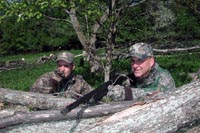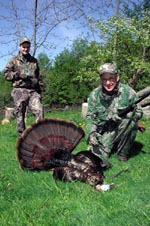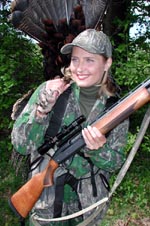
|
Features
|
|
|
|
Books
|
|
|
|
Fun & Games
|
|
|
|
Contact Us
|
|
|
John's Journal... Entry 244, Day 3
HUNTING GOBBLERS IN ANY WEATHER
Snow Gobblers And Bob Wozniak
 Editor's
Note: The rain beat on the tin roof of the camphouse like machine gunfire.
I couldn't believe the rain pouring down on this opening morning of turkey
season. But because my friend Don Taylor of Birmingham, Alabama, and I
wouldn't miss hunting on opening morning, regardless of the weather, we
braved the windy and wet weather outside. Finally at 11:00 a.m., after
rain had soaked me from the tip of my head to the soles of my feet, we
found a lonesome gobbler in a cow pasture and called him in to the gun.
I prefer not to hunt in the rain, wind or snow or under drought conditions,
but like most hunters, I have to hunt when I get the opportunity, whether
the weather conditions favor hunting or not. Often, I'll get a dose of
bad weather on many of the turkey hunts I go on each spring. I always
carry an extra bag with me with raingear, snowsuits and suntan lotion,
because I've learned through the years that bad weather follows me wherever
I hunt. This week, some turkey hunters who take toms under good and bad
weather conditions will tell us their tactics for taking birds in any
weather.
Editor's
Note: The rain beat on the tin roof of the camphouse like machine gunfire.
I couldn't believe the rain pouring down on this opening morning of turkey
season. But because my friend Don Taylor of Birmingham, Alabama, and I
wouldn't miss hunting on opening morning, regardless of the weather, we
braved the windy and wet weather outside. Finally at 11:00 a.m., after
rain had soaked me from the tip of my head to the soles of my feet, we
found a lonesome gobbler in a cow pasture and called him in to the gun.
I prefer not to hunt in the rain, wind or snow or under drought conditions,
but like most hunters, I have to hunt when I get the opportunity, whether
the weather conditions favor hunting or not. Often, I'll get a dose of
bad weather on many of the turkey hunts I go on each spring. I always
carry an extra bag with me with raingear, snowsuits and suntan lotion,
because I've learned through the years that bad weather follows me wherever
I hunt. This week, some turkey hunters who take toms under good and bad
weather conditions will tell us their tactics for taking birds in any
weather.
 Bob
Wozniak of Boston, New York, a member of the Quaker Boy Pro Staff, works
for the New York Department of Fish and Wildlife and guides turkey hunters
in his home state of New York. During New York's spring turkey season,
you'll find Wozniak in the Catskills, the Adirondacks and the Enchanted
Mountains. Often, during the first of turkey season in New York State,
Wozniak will have to hunt in the snow to bag his bird. "I love to hunt
turkeys when snow falls in the spring because the snow doesn't really
affect the turkeys as much as it does the turkey hunters," Wozniak says.
"The snow causes turkey hunters to stay indoors. But the turkeys still
have to feed, scratch, mate, travel and roost -- even in the snow. In
the spring, our area usually will have high winds, too. The wind makes
the hunting of turkeys more difficult than the snow does because you can't
hear the turkeys as well. But when the snow front comes in with a heavy
wind, the wind generally will leave the first day after the snow. Then
the weather becomes calm and stable, even though snow may remain on the
ground. But I've taken gobblers with snow on their backs and have bagged
the birds even when the snow has continued to come down.
Bob
Wozniak of Boston, New York, a member of the Quaker Boy Pro Staff, works
for the New York Department of Fish and Wildlife and guides turkey hunters
in his home state of New York. During New York's spring turkey season,
you'll find Wozniak in the Catskills, the Adirondacks and the Enchanted
Mountains. Often, during the first of turkey season in New York State,
Wozniak will have to hunt in the snow to bag his bird. "I love to hunt
turkeys when snow falls in the spring because the snow doesn't really
affect the turkeys as much as it does the turkey hunters," Wozniak says.
"The snow causes turkey hunters to stay indoors. But the turkeys still
have to feed, scratch, mate, travel and roost -- even in the snow. In
the spring, our area usually will have high winds, too. The wind makes
the hunting of turkeys more difficult than the snow does because you can't
hear the turkeys as well. But when the snow front comes in with a heavy
wind, the wind generally will leave the first day after the snow. Then
the weather becomes calm and stable, even though snow may remain on the
ground. But I've taken gobblers with snow on their backs and have bagged
the birds even when the snow has continued to come down.
 "To
take a turkey in the snow, you have to cover a lot of ground and call
to as many turkeys as possible. If I'm hunting by myself, I like to get
on a ridgetop and walk as far as I can go, calling off either side of
the ridge. But if I'm guiding another hunter, I usually will drive to
10- or 20-different locations in a day and try to call to a bird from
the road. Even though New York has a large number of turkey hunters and
many of them call from the road, when we have a snow storm in the spring,
most of those hunters stay inside by the fire. So on snowy days I enjoy
hunting because I find less competition for the birds. A snowy day seems
to make no difference in the amount of gobbling a tom does or how easily
I can call in a bird. I've noticed, however, that when snow is on the
ground and the weather feels cold, the birds may not start gobbling until
later in the morning."
"To
take a turkey in the snow, you have to cover a lot of ground and call
to as many turkeys as possible. If I'm hunting by myself, I like to get
on a ridgetop and walk as far as I can go, calling off either side of
the ridge. But if I'm guiding another hunter, I usually will drive to
10- or 20-different locations in a day and try to call to a bird from
the road. Even though New York has a large number of turkey hunters and
many of them call from the road, when we have a snow storm in the spring,
most of those hunters stay inside by the fire. So on snowy days I enjoy
hunting because I find less competition for the birds. A snowy day seems
to make no difference in the amount of gobbling a tom does or how easily
I can call in a bird. I've noticed, however, that when snow is on the
ground and the weather feels cold, the birds may not start gobbling until
later in the morning."
TOMORROW: STEVE STOLTZ ON HOT-WEATHER TOMS
Check back each day this week for more about HUNTING GOBBLERS IN ANY WEATHER ...
Day 1 - Rain And Doug Camp
Day 2 - Larry Norton And The Wind
Day 3 - Snow Gobblers And Bob Wozniak
Day 4 - Steve Stoltz On Hot-Weather Toms
Day 5 - Steve Stoltz On Warm-Weather Toms,
Part 2